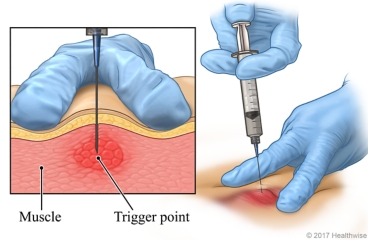What are trigger point injections?
A trigger point is a painful knot in a tight band of muscle. A trigger point often causes pain to be felt in other areas, too. For example, a trigger point in the neck or upper back can cause pain in the head.
Trigger point injections are shots of medicine into these knots to help relieve the pain. The medicines are usually local anesthetics like lidocaine.
Trigger point injections are often part of plan that includes other treatments, such as muscle stretching and strengthening.
How is a trigger point injection done?
Your doctor first locates a trigger point by pressing around the painful area. This may cause your muscle to hurt or twitch. This tells the doctor that it's the right spot to do the injection.
The area is cleaned. Your doctor then injects the medicine into the trigger point. The doctor may inject the medicine in more than one direction within the trigger point. The doctor may change direction without removing the needle.
If you have more than one trigger point in the muscle, your doctor may repeat the process.
Your doctor may stretch the area to help the muscle relax. You may be shown how to move and stretch the muscle yourself.
How long does a trigger point injection take?
The procedure takes about 10 to 30 minutes. How long it takes depends on how many trigger points are treated. But the injection itself takes only a few moments.
What can you expect after a trigger point injection?
The area may feel a bit numb for a few hours. It may also feel sore. Other problems from trigger point injections are rare. There is a chance of a skin infection at the injection site. And if injections are done in the chest area, there is a small risk of puncturing the outer lining of the lung (pneumothorax).
Trigger point injections may reduce some or all of your pain. But the pain can come back after the medicine wears off. If your pain comes back, your doctor may suggest more shots or other treatment for longer-lasting relief.
Follow your doctor's instructions carefully. And tell your doctor about any new or unusual symptoms, such as chest pain or shortness of breath.
Follow-up care is a key part of your treatment and safety. Be sure to make and go to all appointments, and call your doctor if you are having problems. It's also a good idea to know your test results and keep a list of the medicines you take.


